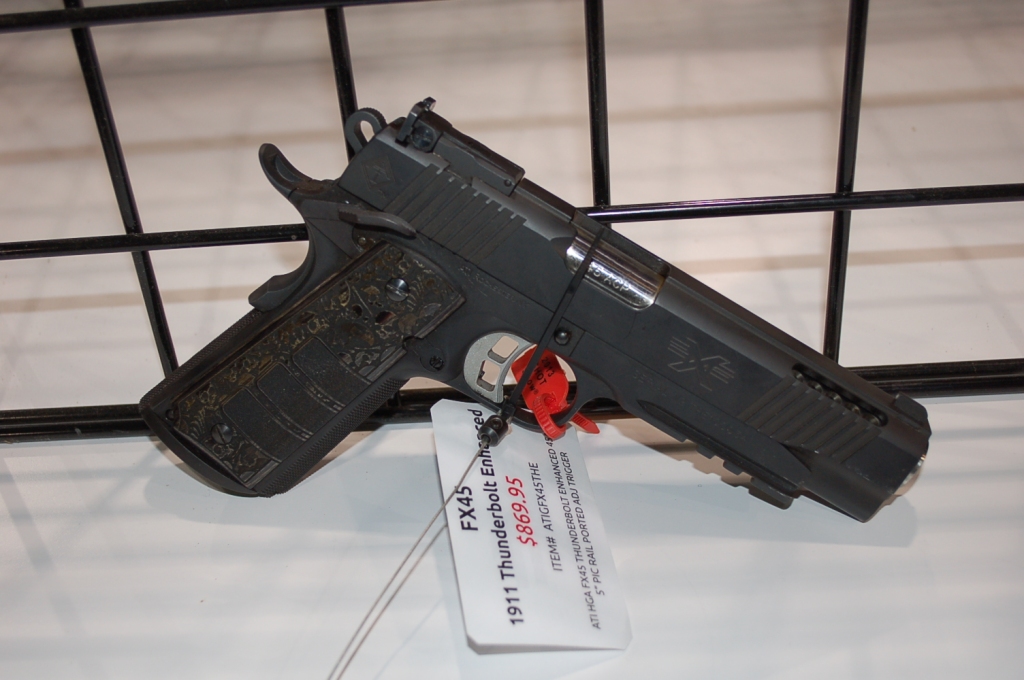I received this information from a friend in the Special Ops community. I thought i’d just cut and paste his email for your reading.This information is in no way classified but I will not use his name for obvious reasons.

Glock 22 40 Cal Rough Frame
The Army did drop the 1911 about 3 years ago for the Glock 22 rough texture frame which was “experimental” at the time. Glock really didn’t know if they were gonna go with it commercially at the time but since others in the community liked it, they put it on some Gen 4 guns.
There was a down select to the STI 2011 and Glock 22 in .40S&W. The 1911 were costing us way to much per gun to keep them running. Parts, labor, X-rays, you get the picture. Even when Kentucky (Lexington Depot) would build a gun, the unit gunsmiths would practically and literally rebuild the gun for the individual operator during the training course. There was a contract let years ago for a select manufacturer to make the frames and slides and several different parts and barrel manufacturers to make the internals. Much like the MEU/MARSOC pistols a while ago they just got to expensive.
And we changed the way we shoot. In training Army it was two in the chest and one in skull if needed. Now, if I give you 1 you are getting 2, if I give you 2 your are getting 5, if you get 5 then you get the rest of the mag. Plain and simple I am not going to let you get up and hurt one of my team mates.
And we will put all my shots right across your pelvis and then the shoulder girdle. I don’t care if you got a trauma team on hand, 5 shots across the pelvis and you ain’t getting up. The enemy is likely to wear some kind of armor now a days just as much as we are. 2 in a 3×5 card ain’t cutting it. So there are lots more ammo expended in training, which effects how well the guns hold up also.
We went through several different down selects for a double stack auto. The STI did not hold up to OTC and the students did not want to run their go-no go shooting test with a chance of failing. One Sabre SQDN got issued both guns and the guys selected to deploy with the Glocks to Iraq. So that ended the question. Now there is a cornucopia of 22’s, 23’s and 27’s across that command. We went from the 228 to the G-19/ G-26 and G-30’s.
And I understand the Navy has dropped the Sig and now gone to the HK (I want to say the) P-30 family in 9mm. I don’t know if they are going to the .40S&W? Air Force STS went to the G-22/23/27 and HK-416 cuz their Army partners did. Really all of JSOC is following what the Army Unit does.
UPDATE

Well here we go again. Just as we think all is lined out we have one service who doesn’t want to play ball. I know the Marines are broke but geez. Of course Mil.com has been wrong before—many times.
Marine special operators may have a new pistol by years’ end, but it won’t be the latest in sidearm technology.
The Corps’ weapons officials are bypassing decades of handgun innovations and sticking with the revered .45 caliber 1911 for its new Close Quarters Battle Pistol.
The service launched the effort to replace the Marine Corps Forces Special Operations Command M45 pistol, another 1911 design, in spring 2010.
The Marines want to take the manufacturing burden off of the internal gunsmiths who currently custom build the M45 and tap a commercial gun maker to provide a similar pistol.
But some military pistol experts maintain that the 1911 design, while extremely accurate, requires more training and care than other modern tactical pistols.
“You’ve got to be more dialed in on keeping it lubed; you’ve got to be more dialed in on trouble-shooting if there is parts or magazine issues,” said Larry Vickers, a well-known tactical pistol instructor and 1911 expert.
Marine weapons officials, however, are satisfied with the design and already have the money for a commercial off-the-shelf 1911 pistol, Clark said. Starting a new pistol program would require additional approval and could be a gamble as billions of dollars in defense cuts loom over all of the services, Marine officials said.
Like the M45, the new Close Quarters Battle Pistol will be “more accurate and more reliable than just the standard 1911” and will be equipped with a Picatinny rail for mounting weapon lights, said Charles Clark III, who oversees infantry weapons requirements at the Corps’ Combat Development and Integration office in Quantico, Va.
Clark acknowledged that the service is in the middle of “source selection” but would not provide any details on the gun manufactures involved in the competition.
One contender is the Springfield Armory Full Size MC Operator, a 1911 design that looks very much like the M45. It has also been reported that the Marines are also looking at a version of Colt’s custom 1911 rail gun.
The Marines hope to make a selection by the end of this year, Clark said.
Like other services, the Corps issues the standard M9 9mm pistol to its conventional troops, and has no plans to change that anytime soon, Clark said.
The service began issuing custom 1911 .45 pistols to its elite Force Reconnaissance units in the 1990s. Gunsmiths at the Quantico Weapons Training Battalion Precision Weapons Section hand built them from old 1911s that had been replaced by the M9 in the mid 1980s.
With the creation of the first MARSOC units in 2006, the Corps began issuing the slightly updated M45. It features improved ergonomics, a custom trigger and better sights.
The problem, Clark said, is that the creation of MARSOC has caused the requirement to grow from 400 pistols to 4,000 pistols. Finding enough surplus 1911s for the Precision Weapons Section’s custom rebuilds became impractical.
That increased growth made it “really unworkable to have a hand-built solution,” Clark said.
Other special operations units — including the Navy SEALs — have upgraded to more modern handguns such as the Sig Sauer P226.
Vickers, who spent his Army career serving in special operations units, teaches the intricacies of the 1911 in one of his most popular Vickers Tactical courses.
In many ways, the 1911 is comparable to the M16 family, Vickers said. It’s extremely ergonomic and very accurate like the M16, but it suffers from reliability problems if it’s not properly maintained.
“It requires a higher degree of end-user sophistication to keep it running,” said Vickers, who prefers a Glock 17 for its reliability and simple design.
Marine officials maintain that the service has the money to replace the M45 with something similar. Choosing a more modern pistol would call for a new requirement, a venture that’s unlikely to win approval as the Pentagon faces massive cuts to defense spending, Clark said.
“With the constrained fiscal environment, getting a new requirement approved requires a separate funding line,” he said.
A bit of proof for the naysayers who seem to refuse to believe the above changes in handguns for the Spec Ops world. These photos are from an un-named arms room. There are Glocks in several models and a few 1911’s. These are gen 3 and gen 4 Glocks. These pics were sent to me from “Taz” and many thanks for his help! As they say a picture is worth a thousand words:-)





Copyright photos
Unauthorized use and/or duplication of this material without express and written permission from this blog’s author and/or owner is strictly prohibited. Excerpts and links may be used, provided that full and clear credit is given to Gunner777 and Gunners Journal with appropriate and specific direction to the original content.
Just comment and chances are I will ok sharing material. Some photos belong to others who do not want them shared. Please respect their wishes.

















